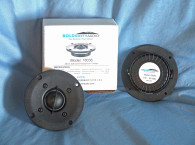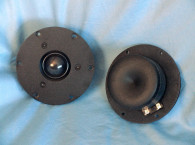
Scan-Speak has been back on their own for a couple of years now and doing well as an independent business entity now that they are no longer a part of DST or Tymphany. Founded in 1970, Scan-Speak is still working out of the same address in Videbaek, Denmark, and with the same “no compromise” philosophy that was always a part of the company’s mission.
One of the latest efforts for Scan-Speak was to develop a new high-quality line of more competitively priced OEM product, dubbed Discovery. The D2604/833000 is the latest tweeter offering from the Discovery line and features a large surround 1″ diameter silk dome, a low 475Hz resonance, CRT shielding, a separate rear chamber, a ferrite magnet motor, an injection-molded faceplate with a five-point mounting configuration, voice coil wound with copper-clad aluminum wire, and gold-plated terminals.




I began testing the D2604/833000 silk dome (Photo 1) by generating a stepped sine wave impedance plot using the LinearX LMS analyzer. The result of the LMS 300-point impedance sine wave sweep is given in Fig. 1. The tweeter resonance is 426Hz, somewhat lower than the factory spec. Minimum impedance for this tweeter is 3.2Ω at 2.4kHz with a measured Re= 3.0Ω.
After completing the impedance measurements, I recess-mounted the Scan-Speak tweeter in a small enclosure that had a baffle area of about 12″ × 7″ and measured the on- and off-axis frequency response at 2.83V/1m. Figure 2 depicts the on-axis response. Frequency response for the D2604 dome is a very flat ±1.75 from 890Hz-16kHz with the response extending to 25kHz. Figure 3 gives the on- and off-axis response for the Scan-Speak wide surround silk dome tweeter. Off-axis the device is -4.5dB down at 10kHz from the on-axis response with respect to the 30° off-axis curve and -7.2dB at 45° off-axis, again with respect to the on-axis response. Figure 4 illustrates the normalized version of Fig. 3. In terms of production consistency, the two-sample SPL comparison is depicted in Fig. 5, indicating the two samples were well matched with some minor variation in the 3-7.5kHz region.
Next, I used the Listen Inc. SoundCheck analyzer and SCM microphone to measure the impulse response with the tweeter recess-mounted. Importing this data in the Listen Inc. SoundMap software produced the cumulative spectral decay plot (waterfall) shown in Fig. 6. While there are no major resonances indicated in this plot, it is very difficult to correlate long decay resonances with subjective performance.



Figure 7 gives the Short Time Fourier Transform (STFT) displayed as a surface plot. Last, I set the 1m SPL to 94dB (5.8V), and the sweep range to 2kHz-20kHz and measured the 2nd and 3rd harmonic distortion at 10cm, depicted in Fig. 8. This shows the relationship between 2nd and 3rd harmonic distortion; however, correlation to subjective preference based on THD is not well established.
For those of you who have not used this format tweeter in a system, it’s a great design and one of my favorites. All of the various incarnations I have designed into systems have sounded very good, and given the quality and craftsmanship always exhibited by Scan-Speak, this is a great addition to their new Discovery line. For more information on these and the other new Scan-Speak drivers, visit the Scan-Speak website at www.scan-speak.dk.

This article was originally published in Voice Coil, February 2011.







